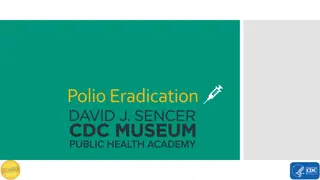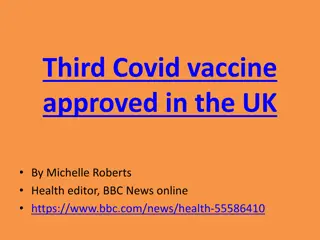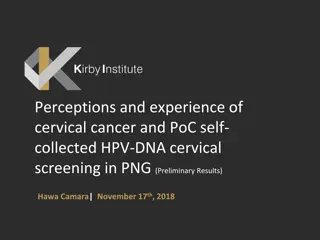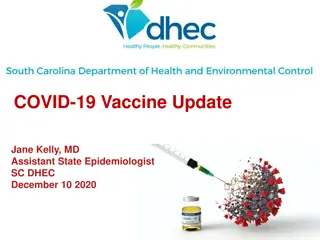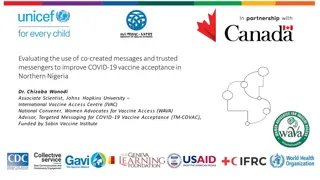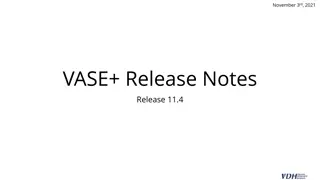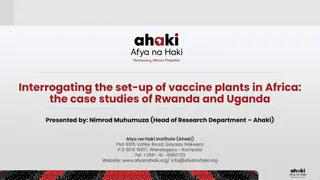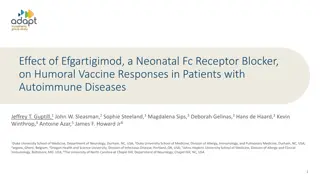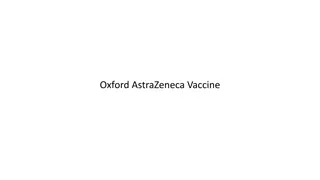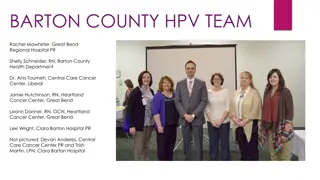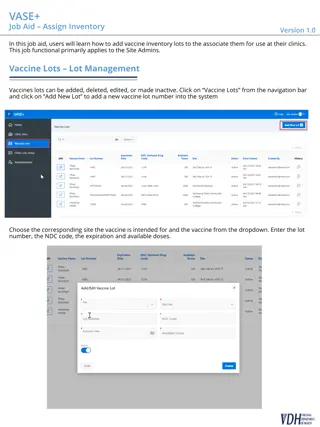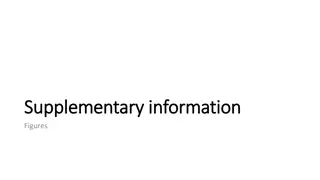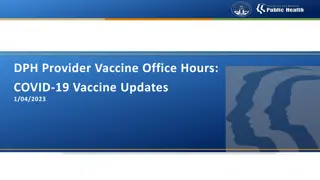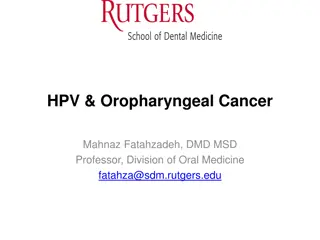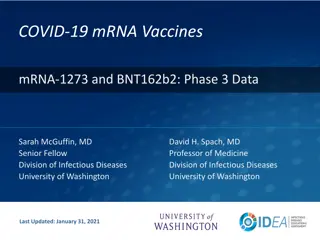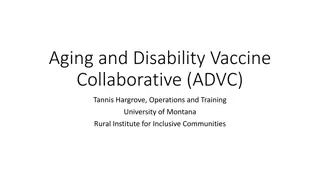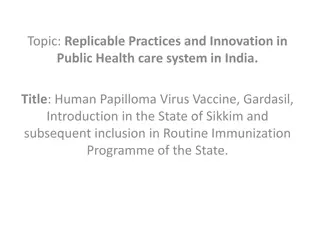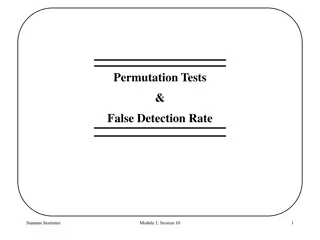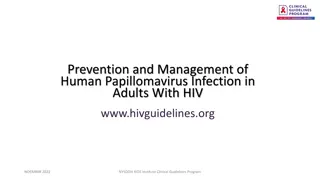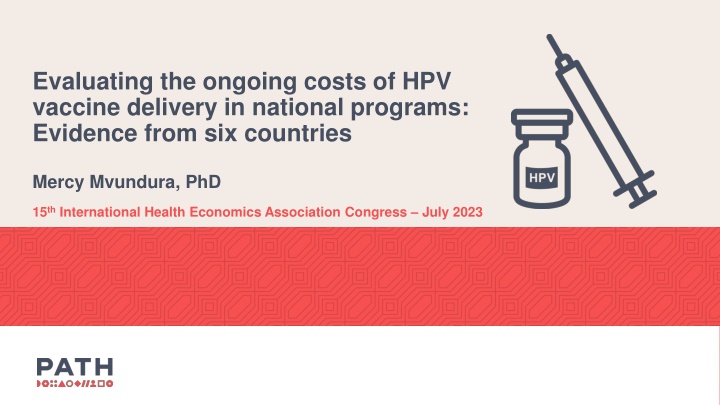
Ongoing Costs of HPV Vaccine Delivery: Evidence from Six Countries
Study evaluating the ongoing financial and economic costs of delivering a two-dose HPV vaccination schedule in national programs across Ethiopia, Guyana, Rwanda, Senegal, Sri Lanka, and Uganda. Includes sample selection, data collection methods, and study components.
Download Presentation

Please find below an Image/Link to download the presentation.
The content on the website is provided AS IS for your information and personal use only. It may not be sold, licensed, or shared on other websites without obtaining consent from the author. If you encounter any issues during the download, it is possible that the publisher has removed the file from their server.
You are allowed to download the files provided on this website for personal or commercial use, subject to the condition that they are used lawfully. All files are the property of their respective owners.
The content on the website is provided AS IS for your information and personal use only. It may not be sold, licensed, or shared on other websites without obtaining consent from the author.
E N D
Presentation Transcript
Evaluating the ongoing costs of HPV vaccine delivery in national programs: Evidence from six countries Mercy Mvundura, PhD 15thInternational Health Economics Association Congress July 2023 1
Study background and methods 2
Study rationale and objective Objective Rationale Limited data on the cost of routine human papillomavirus (HPV) vaccination programs. Estimate the ongoing annual financial and economic costs to deliver a two-dose HPV vaccination schedule, with a focus on costs to the health system and supporting platforms. Prior economic research mostly done at introduction or in pilot phases. Understanding ongoing costs can help inform budgeting, planning, and program sustainability. 3
Focal countries Included in study 4
Sample selection and study country characteristics Stratified random sampling of lower administrative offices and health facilities Criteria-based purposive selection of regions : Sample selection Ethiopia Guyana Rwanda Senegal Sri Lanka Uganda Sample sizes Health facilities 60 43 42 56 30 66 Districts 17 n/a 11 14 10 22 Zones or provinces 9 n/a n/a n/a n/a n/a Regions 3 4 n/a 7 n/a n/a National office 1 1 1 1 1 1 Month and year of HPV vaccine introduction Oct. 2018 Dec. 2018 Jan. 2017 Apr. 2011 Jan. 2017 Oct. 2015 Reference year for the study 2019 and 2020 2019 2019 2019 2019 2019 Reported national target population for HPV vaccination 1,284,036 15,000 149,111 204,235 173,130 681,758 In Guyana, interviews were conducted in five regions; however, data were lost in one region. In another region, two health offices were interviewed, resulting in five observations at the subnational level in four regions. Note: All data from calendar year 2019, except Ethiopia where data were from September 2019 to January 2021 as this was the period to vaccinate the cohort. 5
Study components and data collection methods Components of the study Costing Operational research Using ingredients-based, micro-costing methods following Expanded Programme on Immunization Costing and Financing methodology. Approach based on implementation science methods. Adapted questions from World Health Organization (WHO) HPV Post-Introduction Evaluation (PIE) tool. Data collection methods Primary data collection via interviews using ODK software on tablets Structured electronic questionnaires covering costing and operations components of the study. Secondary data collection Data extraction on vaccination sessions from health facility records. Extraction of vaccination data from electronic databases for the national and sub-national administrative levels included in the study. Unit prices from secondary data at national level including data on salaries, purchase price of equipment, fuel prices, etc. 6
HPV vaccination program activities and cost categories evaluated HPV vaccination program activities evaluated Cost categories evaluated for each program activity as relevant Economic costs Vaccine procurement Estimating demand Program planning and management Social mobilization and IEC Training Vaccine collection or distribution and storage Service delivery Supervision Record keeping Waste management Crisis management Financial costs Opportunity costs Opportunity costs for use of existing resources by HPV vaccination program Direct financial outlays or expenditures for HPV vaccination program + Per diems Meeting costs Vehicle rental and public transport Fuel for vehicles and other equipment, energy for cold chain equipment, and vehicle maintenance Radio messages or printing and distribution of materials for social mobilization Shipping, handling, and customs for vaccine Other costs, such as making copies or procuring additional supplies Health worker time Non-health worker time such as Ministry of Education staff and community stakeholders Annualized cost for vehicles and equipment (incinerators, refrigerators, and vaccine carriers) Levels of the health system included National level Subnational level(s) Health-facility level IEC: information, education, and communication 7
Data analyses The operational context data were tabulated as frequencies and counts to provide information on each facility s context for HPV vaccine delivery. For allocating other shared resources, such as equipment and vehicles, costs were allocated using tracing factors: o Quantity-based proportions. o Volume-based proportions. Data that were extracted from vaccination session forms were used as denominators when computing the cost per dose at health facilities for the costing analysis. The costing data were analyzed in Stata software. Generic analysis files were developed then adapted for each country s context. Data were analyzed disaggregated by the level of the health system, and estimates were presented by cost category and activity. Volume weighted unit cost estimates (cost per dose) are reported. Capital costs were annualized using a 3% discount rate. All costs are reported in 2019 US$ and represent the annual ongoing HPV vaccination program cost. All cost estimates are reported excluding the value of vaccines and supplies. Human resources time use and resources spent on meetings and trainings were allocated to HPV vaccination activities based on the proportions reported by respondents during the interviews. 8
Results 9
Estimated mean financial and economic costs per facility/office Ethiopia Guyana Rwanda Senegal Sri Lanka Uganda Financial costs Health facilities $421 $164 $218 $497 $189 $406 Districts Zones or provinces Regions $678 n/a $304 $4,380 $459 $8,947 $15,503 n/a n/a n/a n/a n/a $44,592 $1,016 n/a $2,950 n/a n/a National $86,751 $25,012 $149,866 $1,930 $1,564 $297,483 Economic costs Health facilities $1,556 $1,979 $1,082 $2,169 $3,190 $1,207 Districts Zones or provinces Regions $4,833 n/a $1,277 $7,313 $1,807 $10,624 $18,485 n/a n/a n/a n/a n/a $58,604 $12,570 n/a $8,685 n/a n/a National $96,840 $60,944 $161,219 $11,568 $7,657 $304,278 10
Weighted mean cost per dose across all levels of the health system $20 $16 $12 $15.10 $8 $8.67 $4.35 $4.96 $4 $3.61 $2.06 $3.27 $3.23 $2.23 $2.10 $1.03 $0 $0.27 Ethiopia Guyana Rwanda Senegal Sri Lanka Uganda Financial costs Opportunity costs Ethiopia Guyana Rwanda Senegal Sri Lanka Uganda Average number of doses delivered per health facility 411 170 613 212 761 162 HPV vaccine doses delivered at national level 2,277,500 29,493 292,892 291,454 314,815 1,035,269 11
Weighted mean financial cost per dose by activity across all levels of the health system $0.00 $0.50 $1.00 $1.50 $2.00 $2.50 $3.00 $3.50 Ethiopia Vaccine procurement Estimating demand Guyana Program planning Social mobilization Rwanda Training Crisis management Vaccine delivery and storage Senegal Waste management Service delivery Sri Lanka Supervision Record keeping Uganda 12
Key takeaways Most HPV vaccine doses administered though school-based delivery. Service volume matters and is a driver of cost per dose estimates. Some ongoing costs are lower than at introduction. There may be opportunities for program cost reductions. 13
Study limitations Due to the COVID-19 pandemic, data collection was done at least two to three years after the HPV vaccination activities were conducted, subjecting our findings to recall bias. This is a cross-sectional study, so we cannot provide insights on how costs change from one year to the next. There were challenges with the availability and/or completeness of records, such as tally sheets and HPV vaccination reports, at some health facilities in the study sample. This may have resulted in an underestimation of the doses used and an overestimation of the costs per dose. Some data to calculate costs were missing at administrative levels of the health system. As such, mean costs per administrative level, and hence the cost per dose at administrative levels and the aggregated costs across all levels of the health system, are underestimated because these costs were not included in the analysis. 14
Study teams and acknowledgments HPV Vaccine Cost of Delivery and Operational Context Study 15
Study teams by country Guyana Ethiopia Rwanda Senegal PATH D. Scott LaMontagne Rose Slavkovsky Elisabeth Vodicka PATH Amare Bayeh Mercy Mvundura PATH Mercy Mvundura Jacqueline Anena PATH Cathy Ndiaye Abdou Diop Fr d ric Debellut Elisabeth Vodicka Federal Ministry of Health Meseret Zelalem Yohannes Lakew Mengistu Bogale Melkamu Ayalew Ministry of Health Clarisse Musanabaganwa Hassan Sibomana Francois Uwinkindi Ministry of Public Health Ertenisa Hamilton Ganesh Tatkan Serena Bender-Pelswijk Oneka Scott Ministry of Health Ousseynou Badiane Sri Lanka Uganda Ethiopia Public Health Institute Adugna Dufera Consultant Premchand Persaud PATH Fr d ric Debellut D. Scott LaMontagne Sandeep Kumar PATH Jacqueline Anena Teddy Naddumba Consultant Belayneh Dagnew Ministry of Health Alfred Driwale Immaculate Ampeire Frehd Nghania John Kissa Ministry of Health Samitha Ginige Thilanga Ruwanpathirana Manjula Kariyawasam Sashimali Wickramasinghe Chinthana Perera Nirmala Coory Consultant Deepa Gamage 16
PATH global study team and acknowledgments Coordination and administration Data management and ODK programming Operations data analysis Principal investigators Mercy Mvundura D. Scott LaMontagne Rose Slavkovsky Ruth Gebreselassie Kerry Laurino Jenny Johnson Juliette Arnaud Clint Pecenka Data management Lydia Nguti Jacqueline Anena Amare Bayeh Kayla Betz Moses Mwebembezi ODK programming Papa Sokhna PATH gratefully acknowledges the collaboration of the immunization programs in the study countries and the kind and generous cooperation of all immunization program staff who participated in the study interviews and provided requested data. In addition, the study team acknowledges the consultants who participated in activities such as programming electronic data collection tools, study coordination, and supervision. The study team is also grateful to the enumerators who conducted the data collection activities. This work was made possible through funding from the Bill & Melinda Gates Foundation. 17
THANK YOU! Mercy Mvundura, PhD Health Economics Technical Advisor, PATH mmvundura@path.org 18

